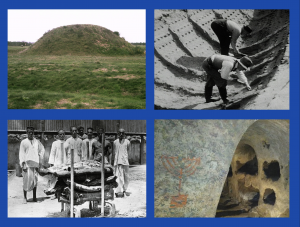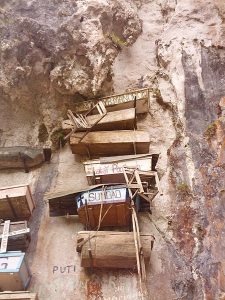2.1 Death Related Customs & Rituals in History
There are an abundance of death-related beliefs and practices (e.g., customs and rituals) that we as humans have used to deal with our dead (McRae, 2018; San Filippo, 2006). Through end-of-life (EOL) rites, the living honour the dead and/or address fears of the dead (e.g., the threat the dead pose to the living) (Powell, 2019; San Filippo, 2006). For example, the practice of closing or covering the eyes or the face of the dead and moving bodies feet first, were meant to protect the living (Rodgers, 2017; Powell, 2019). The former practice is believed to have started as a way to close a “window from the living world to the spirt world” (Powell, 2019, para. 2). The latter practice was tied to the belief that if a body was moved headfirst, it could look back and beckon the living to follow them (Rodgers, 2017). The fear of calling a loved one to follow is also part of the reason why widowed Victorian women wore black. The belief was that dressed in black, they would appear as a shadow and were therefore at less risk of being beckoned by the spirits of their dead husbands to join them (Currie, 2017).
Click the following link to read about Victorian mourning culture:
Why I Wore Black After He Died: Lessons from Victorian Mourning Culture
When exploring death related practices historically, it is also important to look at the disposal of dead bodies. Archeological research details the numerous ways bodies have been dealt with. Dead bodies were left in caves, in trees or on mountaintops, burned on pyres or other forms of ritual cremation, placed in catacombs, buried in the ground or under mounds of earth. For example, early Italian farmers about 7000 years ago placed their dead in caves, after they defleshed and then broke apart the skeletal remains (Shaw, 2015). Anglo-Saxons (from the 5th-10th century) buried their dead in organized graveyards, using small burial mounds as markers for each. However, much larger barrows/burial mounds were also built by the Anglo-Saxons to honour their high-status dead, possibly kings (see top left and top right image below) (Davidson, 1950; Carver, 1986).

According to ancient Hindu custom, the Hindu funeral/cremation ceremony involves placing the dead on a pyre of logs and then setting it alight (see bottom left image above). This tradition is still the dominant practice today (Mikles, 2021). In other parts of the world (e.g., Rome, Paris, Lima), at different periods of time, the bodies or bones of the dead were placed in catacombs. The Roman catacombs, dating back to the first century, “were constructed as underground tombs, first by Jewish communities and then by Christian communities” (see bottom right image above) (Sood, 2012). And among the Igorot people of the Philippines, there is an ancient practice dating back 2000 years (and still practiced today), involving the suspending of coffins on the side of a cliff, in order to allow the dead closer proximity to ancestral spirits who predeceased them (see image below) (Dilger & Hizon, 2018).

Click the following links to read about historical perspectives on death and dying:
Death, Burial & the Afterlife in the Ancient Celtic Religion
What Ancient Cultures Teach Us About Grief Mourning and Continuity of Life

